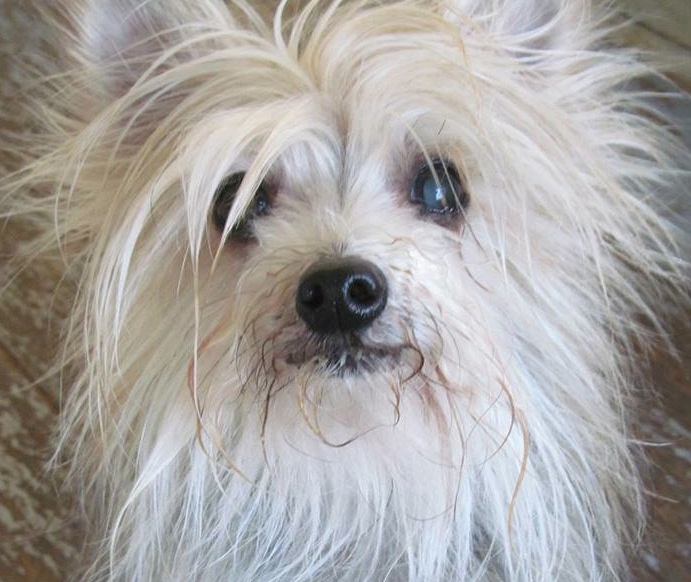
Last week, I detailed the steps for encouraging a dog to be comfortable enough to approach you closely enough to eat food off the floor near you . . . or even “off” you—food that you’ve placed on your shoes, for instance. You’ve worked through those steps and practiced with all the variables, adding different locations and distractions until the dog is taking food under a variety of conditions.
Now it’s time to add actual physical contact with you: taking food from your hand.
- Sit down in a spot where you’ve practiced this exercise with your dog many times.
- Start without distractions. Just you and the dog in a place he feels very safe.
- Leave a “trail of breadcrumbs” across the floor to yourself. Not breadcrumbs, of course, but some of the dog’s favorite food treats.
- Rest your hands, palms up, on the floor at your sides, holding high-value food. I suggest cooked chicken, tube meat, hot dog slices, cheese—whatever you think will interest the dog most.
- Stay absolutely quiet and calm as the dog approaches.
- Look away from the dog, and say nothing. Stay still.
- Expect the dog to take time deciding whether or not to approach you, but don’t be surprised if you feel a wet nose or a licking tongue on your hands immediately. Either way—do not react!
Twitching in surprise when the dog touches your palm would be extremely counterproductive, of course. Movement or verbal praise is not appropriate at this point, but neither is robotic stillness. Relax, breathe, be calm.
If you have any fear that your dog will hurt you, now that you’re inviting him to take food from your hand, this is not the exercise for you to be doing with him. If you’re afraid, you may not be able to control your physical reactions and your dog will very likely sense your discomfort and concern, interpreting it as simply not safe . . . exactly what you do not want.

Once the dog is eating food from the palm of your hand as it’s resting on the floor, it’s time to go through all the same steps you worked through to get him to that point, slowly adding distractions and changes of location over time, so the dog becomes willing and eager to eat the food in your hand while you sit on the floor in various spots around your home.
- Measure the food you’ll use before each training session.
- Keep a written list of the amounts used every day.
- Decide the total amount of food to be used in a day and don’t exceed it, even if you’re still feeding some of that daily measurement in the dog’s bowl. Feeding from the bowl is not necessary at all, of course, as long as the dog is eating his daily amount from the floor and from your hand.
You can vary the number of times you feed from the floor and from your hand every day, depending on your availability and time to do the training. Don’t worry if you must miss a day or even two. Take it slowly when you return to the training, going back a few steps if you think it’s necessary for your dog to rebuild some confidence.
When your dog is confidently eating food from your unmoving palm regularly—maybe even eating all his food that way instead of out of a bowl—it’s time to lift your hand off the floor and offer the food that way instead. Only a few inches off the floor at a time, please!
If you find it’s not comfortable for you, for whatever reason, to hold your hand motionless a few inches off the floor, find something to support that hand so it can remain still. As you continue training the exercise, add height to whatever you use to rest your hand on. (The point here is that you must be physically comfortable yourself.)
Again, if the dog will confidently eat food from the palm of your hand with your hand several inches off the ground, continue this stage of the training by adding the various scenarios you have before—different sitting locations on the floor, in different rooms, with different distractions. Vary the environment through sound (turn on the radio, for example), surroundings (various rooms, bottom of the stairs, on the landing), and other humans present (in the kitchen while someone else is ignoring you and the dog, going about some quiet activity like washing dishes).
Your goal is for your dog to accept all these changes, all these new scenarios, as non-threatening—enough so that the dog is still willing and eager to eat from your hand. As always, take your time, be patient, and don’t make huge leaps ahead. Build the dog’s confidence slowly and surely.
You may opt to add quiet verbal praise as your dog eats.
Experiment. If your quiet praise doesn’t seem to distract or worry the dog, continue. Try speaking in a very calm, non-chirpy voice. Imagine you are speaking to a baby who’s falling asleep. Should your voice jar the dog, stop praising at that stage and try again later. Eventually, hearing your voice while he eats should become a non-issue to your dog . . . but don’t press your luck at this early stage.
Over time, raise the distance of your hand from the floor and try your hand—still palm up—in other positions, like resting on your knee, for example. With smaller dogs, try holding your hand closer to your body, so the dog will find it necessary to put a paw or paws on your legs to get to the food you’re holding.
Again, experiment. You want the dog not to be leery of touching you, but you don’t want him climbing up your torso, either! With larger dogs (or if it’s simply your own preference not to have the dog touching you with his paws), it’s probably best not to encourage too much climbing on the human, for obvious reasons.
Next stage in teaching the dog to take food from your hand confidently? Work up to a change of physical position for you. Instead of sitting on the floor, sit on a couple of cushions or short stool, raising your body off the floor. Repeat the changing scenarios of surroundings and locations. Over time, if your dog remains confident, move onto sitting on the sofa or in a chair. Hold your hand where the dog can easily reach it without climbing onto you—lower down for shorter dogs, higher up for taller dogs.
Be careful not to “tower over” your dog as you move to a higher up position. Reach your hand out, but don’t lean down with your whole upper body. Never reach out to push the hand with the food at your dog, as if to say, “Here, dummy, this is what you’re supposed to eat!” Always let the dog come to you.
You may experience moments where the dog is simply not interested in playing the food-in-your-hand game. Should those moments turn into days, consider why. It could be your dog is “off his feed” for some reason unrelated to your training. If the dog is not eating from his bowl either, it’s probably time to think about contacting your veterinarian. It’s pointless to imagine that you’re doing something wrong—or that the dog is being difficult—when in fact the dog has an upset tummy or a urinary tract infection. Get a clean bill of health from your veterinarian before you continue training.
The ultimate goal for this “thinking out of the bowl” training is to allow the dog to develop his confidence in you, his caregiver. When you can, in time, stand at your full height (or kneel, if you have a short dog) and offer food from your open palm, and the dog approaches and eats the food without hesitation, you’ve come a very long way! Now there’s a good chance you can continue your training by giving food rewards directly from your hand to the dog, repeatedly throughout a training session.
When do you feed the dog from a bowl?
When you don’t have time to train, feed the dog from a bowl—or a food-dispensing toy—as necessary. But don’t let your dog ever look at his bowl as the only “source” of his food. By training “outside the bowl,” you build his confidence in you and in the training process, so that he knows that proximity to you is safe, that you are safe, and that taking food from you is not only safe, but good!



